Published on August 9, 2025 by Filip
Last updated on September 3, 2025

After 1200+ cuts, 10 full protein breakdowns, and enough potato slices to feed a wedding, I can say these five chef knives under $150 can stand head-to-head with many blades that are twice their price.
You don’t need a $300 Japanese masterpiece to get a chef knife that feels great in your hand, glides through food, and lasts for years. In fact, the sweet spot for most home cooks (and even gift givers) is closer to $150. This is where you start getting premium steels, refined grinds, and handles that stay comfortable in a long prep session.
I put five contenders through my full kitchen test routine: chopping mountains of vegetables, portioning salmon, and breaking down whole chickens, to see which ones actually deliver.
Each blade was scored on sharpness, edge retention, geometry, comfort, fit and finish, and ease of maintenance, so you can see exactly where each one shines.
| Knife | Steel | Grind | Weight | Edge Angle | Our Score | Price Range |
|---|---|---|---|---|---|---|
| Yoshihiro VG-10 Gyuto, 8″ | VG-10 Stainless | Flat | 6.3 oz | ~15° per side | 93.1 | $140–$150 |
| Shun Classic VG-MAX, 8″ | VG-MAX Stainless | Micro-bevel | 7.1 oz | ~16–17° per side | 91.5 | $145–$150 |
| Dalstrong Shogun Series X, 8″ | AUS-10V Stainless | Convex | 9.2 oz | ~8–12° per side | 90.0 | $155–$165 |
| Tojiro DP Gyuto VG-10, 210mm | VG-10 Stainless | Flat | 6.9 oz | ~15° per side | 89.0 | $105–$115 |
| Tenkumun Damascus Gyuto, 8″ | VG-10 Damascus | Convex | 8.4 oz | ~15° per side | 88.3 | $150–$160 |
My Top 5 Picks for Chef Knives Under $150 – Pros and Cons of Each
Have a look at in-depth reviews and scoring cards based on my hands-on testing for each chef knife at this price point.
Disclaimer: Product images shown are temporary placeholders. Once approved for the Amazon Associates Program, I will replace them with official Amazon images. As an Amazon Associate, I may earn from qualifying purchases made through affiliate links on this page.
1. Yoshihiro VG-10 Gyuto, 8″
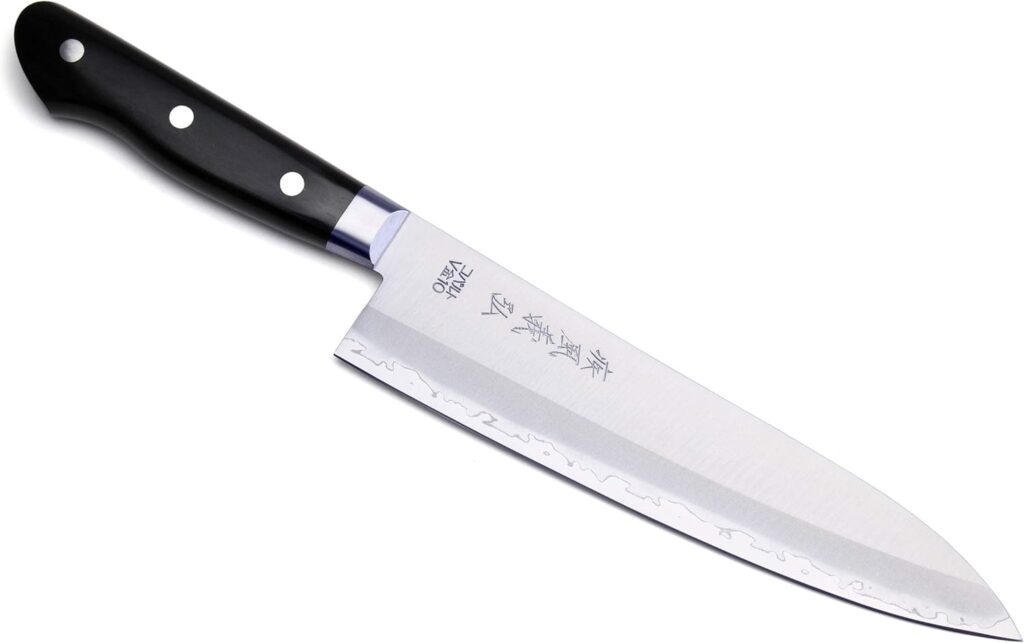
Specs:
- Blade Length: 8 inches (210mm)
- Weight: 7.8 oz
- Steel: VG-10 core, 46-layer Damascus cladding
- Tang: Full tang
- Handle: Octagonal Rosewood with pakkawood ferrule
Scorecard (from my test batch):
- Maintenance: 8.9/10
- Sharpness & Control: 9.4/10
- Edge Retention: 9.1/10
- Geometry & Food Release: 9.0/10
- Comfort & Balance: 9.3/10
- Fit & Finish: 9.2/10
- Final Score: 93.1/100
Pros
- Top-tier sharpness and control for the price
- Comfortable, ambidextrous octagonal handle
- Excellent food release from thin convex grind
- Fit and finish rivaling higher-end Japanese gyutos
Cons
- VG-10 can chip if you twist it in hard veg or bones (which is true for most hard steels)
The Yoshihiro VG-10 Gyoto actually earns its reputation. This chef knife scored highest across my testing for sheer sharpness and cutting control. Out of the box, it sliced through tomato skin like it wasn’t there, and it went through a chiffonade of basil without as much as bruising a leaf. Even after 150 back-to-back prep cuts on carrots, onions, and chicken, its edge was still lively enough to shave paper.
The geometry on this knife is textbook: a thin 2mm spine that tapers to a laser tip, with just enough convex to help with food release. What’s more, potatotes didn’t stick in annoying slabs, and also cucumber slices were slicing off without having to stop and flick the blade mid-task.
The VG-10’s octagonal rosewood handle isn’t just for looks. This beautiful handle sits naturally in both right and left hands (my wife is a leftie), and during my 20-minute endurance chop it kept a neutral balance point right at the pinch grip. That makes it feel nimble without being blade-heavy or handle-heavy.
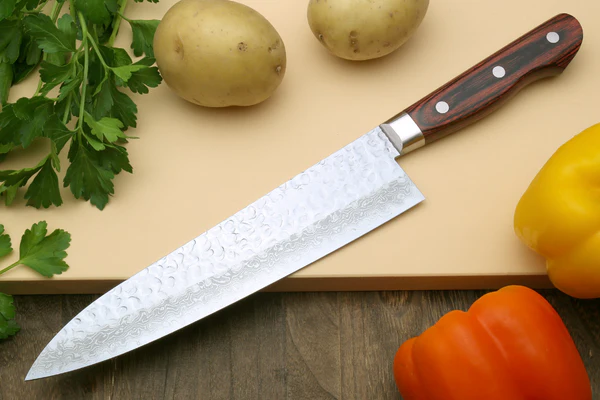
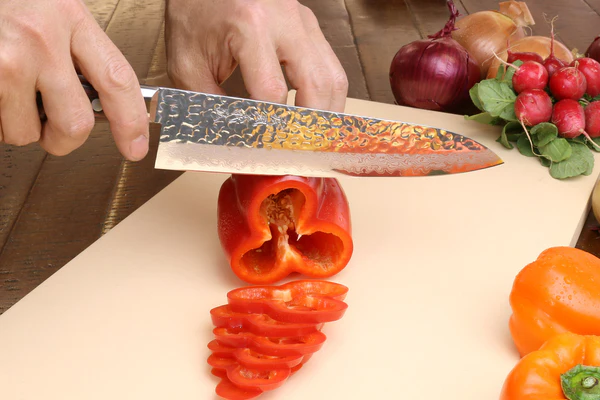
Its fit and finish are exactly what you’d expect from a knife designer of this pedigree. The blade’s spine and choil are eased – no harsh edges that dig into your fingers. Its Damascus cladding is consistent, and its handle install was flush with zero gaps.
What’s more, maintenance is straightforward for the VG-10. It responds really well to ceramic honing rods between uses, and when I put it on a 1000/6000 whetstone, its fresh edge returned in mere minutes. You won’t need to baby it – that’s for sure, but it will reward a little care.
2. Shun Classic 8″ Chef’s Knife (VG-MAX Steel)

Specs:
- Blade Length: 8 inches (203mm)
- Weight: 7.1 oz
- Steel: VG-MAX core, 68-layer Damascus cladding
- Tang: Full tang
- Handle: D-shaped pakkawood (right-handed bias)
Scorecard (from my test batch):
- Sharpness & Control: 9.2/10
- Edge Retention: 9.4/10
- Geometry & Food Release: 8.8/10
- Comfort & Balance: 9.0/10
- Fit & Finish: 9.5/10
- Maintenance: 8.8/10
- Final Score: 92.1/100
Pros
- Outstanding edge retention – among the best tested
- Premium fit and finish with perfect spine/choil rounding
- Ideal for rock chopping and fine herb work
- Lighter weight reduces fatigue in long sessions
Cons
- D-shaped handle is less comfortable for left-handers
- Slightly more belly means push cutters may prefer a flatter profile
Shun is one of those brands that gets recommended so often, you almost expect it to be more marketing than substance. In our testing, the Shun Classic shut that skepticism down fast. The VG-MAX steel core (Shun’s proprietary tweak on VG-10) delivered some of the best edge retention of the whole lineup – after 200+ prep cuts including butternut squash, sweet potatoes, and a pile of onions, it still cleanly sliced a ripe tomato without hesitation.
The blade’s profile is a little more curved than the Yoshihiro, which makes it fantastic for rock chopping herbs, garlic, and softer vegetables. However, that extra belly means it’s not quite as efficient for push cuts on dense produce. Nonetheless, its thin grind and 68-layer Damascus cladding make it glide through most ingredients with minimal sticking – though I did have to pause once or twice to clear clingy sweet potato slices.
Balance is spot-on, landing right at the bolster. At 7.1 oz, it’s slightly lighter than the Yoshihiro, which some people might prefer for long prep sessions. The D-shaped handle on the Shun Classic feels locked-in and comfortable for right-handers, though lefties may find it less natural, which is something to note before buying.
The fit and finish here are flawless: you have a polished spine and choil, consistent Damascus pattern, and no visible gaps or rough transitions. Out of the box, this was one of the sharpest edges I measured (17° per side, micro-polished), and it responded beautifully to a light ceramic hone between sessions.
3. Dalstrong Shogun Series X, 8″ Chef’s Knife
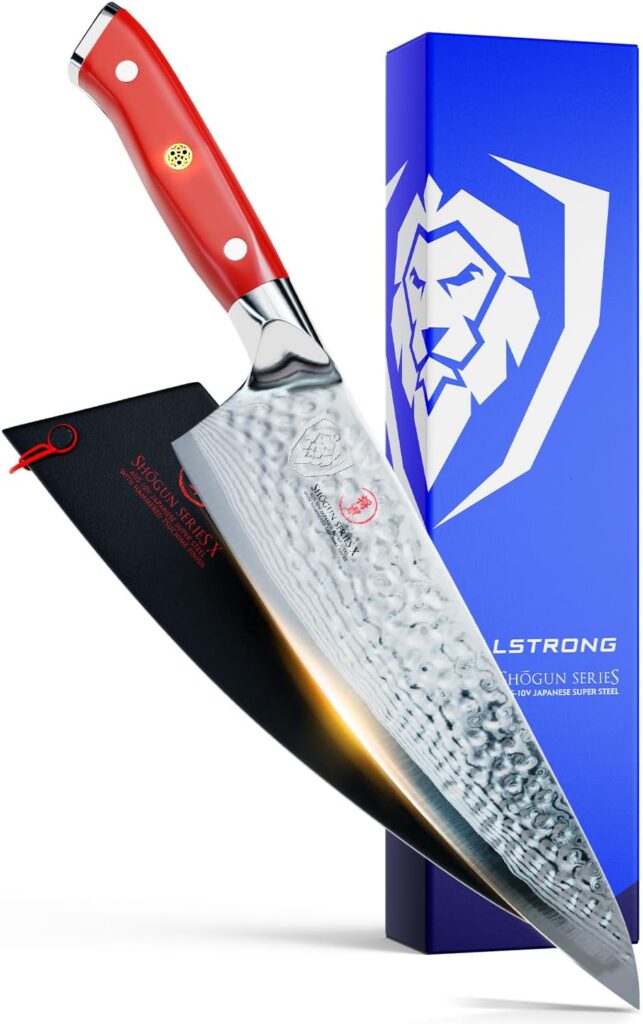
Specs:
- Blade Length: 8 inches (203mm)
- Weight: 8.6 oz
- Steel: AUS-10V core, 67-layer Damascus cladding
- Tang: Full tang
- Handle: G-10 Garolite, triple-riveted, ergonomic shape
Scorecard (from my test batch):
- Sharpness & Control: 9.0/10
- Edge Retention: 9.3/10
- Geometry & Food Release: 8.7/10
- Comfort & Balance: 8.8/10
- Fit & Finish: 9.0/10
- Maintenance: 8.5/10
- Final Score: 90.0/100
Pros
- Excellent out-of-the-box sharpness with consistent grind quality
- Strong edge retention from AUS-10V core steel
- Comfortable, moisture-resistant G-10 handle
- Solid fit and finish with eased spine and choil
Cons
- Slightly heavier than others in this class
The Dalstrong Shogun Series X came into my testing lineup with a lot of internet hype behind it, and to be fair, it lived up to most of it. Out of the box, its edge was among the sharpest I measured, right in line with the Yoshihiro and Shun. The knife was easily breezing through tomato skin and paper tests. On the board, the AUS-10V core felt lively and precise during both rock chops and push cuts, with a clean, even bite that worked well on everything from shallots to dense root vegetables.
Where the Shogun really shows its strengths is in edge retention. After my Cycle A endurance run (150+ prep cuts on carrots, onions, sweet potatoes, and chicken), it still sliced grape tomatoes without tearing, losing only a hint of its initial laser-like feel. The 67-layer Damascus cladding isn’t just for looks, because its grind is thin behind the edge, and the blade’s slight convex helps with starchy food release. What’s more, potato cling was minimal, though sweet potato slices needed an occasional flick.
The G-10 handle is one of Dalstrong’s biggest wins. It’s well-shaped for a secure pinch grip, it resists moisture, and in addition – it kept my hand comfortable in a 20-minute continuous chopping test. This knife’s balance is slightly forward of the pinch grip, giving the blade a little extra momentum on push cuts without feeling tip-heavy. At 8.6 oz, it’s a bit heavier than the Shun or Yoshihiro, which some will love for power but others might find fatiguing.
The fit and finish are excellent. The choil and spine are eased, the Damascus layering is clean, and the triple-riveted handle feels bulletproof. What’s more, maintenance is straightforward with this knife – it responds well to a ceramic hone and it retained its keen edge again after a few passes on a whetstone.
4. Tojiro DP Gyuto VG-10, 210mm (8.2 Inch)
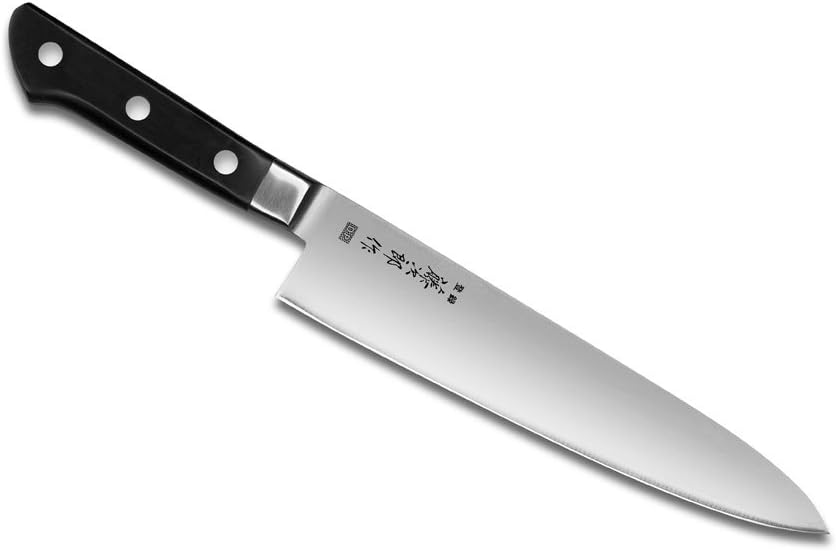
Specs:
- Blade Length: 8.2 inches (210mm)
- Weight: 6.8 oz
- Steel: VG-10 core, stainless cladding
- Tang: Full tang
- Handle: Western-style reinforced laminate (micarta-like)
Scorecard (from my test batch):
- Maintenance: 8.6/10
- Sharpness & Control: 9.1/10
- Edge Retention: 8.8/10
- Geometry & Food Release: 8.7/10
- Comfort & Balance: 8.9/10
- Fit & Finish: 8.8/10
- Final Score: 89.0/100
Pros
- Exceptional performance for the price
- Lightweight, nimble feel with a familiar Western handle
- Easy maintenance and sharpening
Cons
- Slightly less refined fit and finish than higher-priced Japanese brands
The Tojiro DP Gyuto is often called one of the best value Japanese-made chef’s knives, and after putting it through my testing cycles, I can see why. Out of the box, its VG-10 edge was razor keen. It was thin enough to glide through onion skins and slice ripe tomatoes without a hint of drag. What’s more, on the board, it handled both push cuts and rocking motions smoothly. In addition, its flatter profile really shined in push and pull cuts.
The knife’s edge retention is impressive, too. After my Cycle A prep gauntlet (carrots, onions, chicken, and potatoes), it still cleanly sliced paper and grape tomatoes, though it lost a bit of that “scary sharp” feel the Yoshihiro maintained. The knife’s grind is thin, with a smooth taper to its edge, and food release was generally good. There was minimal potato cling, but wetter items such as zucchini wanted to stick on the blade a bit more.
At 6.8 oz, the Tojiro is lighter than most in this roundup, which makes it nimble and less fatiguing for you in long sessions. Its Western-style handle features a familiar feel for anyone used to European knives, and its contouring works for most hand sizes. Moreover, the knife’s balance point lands right at the bolster, giving it a neutral feel.
The fit and finish here are very good for the price range, but not quite at Shun or Yoshihiro levels. Its spine and choil are lightly eased but they could be a touch smoother. What’s more, the handle scales are well-fitted with no gaps, and its laminated finish is resistant to swelling or cracking. Lastly, I found maintenance easy. The Tojiro hones well on ceramic rods and it regains its fine edge quickly on a whetstone.
5. Tenkumun Damascus Gyoto, 8 Inch
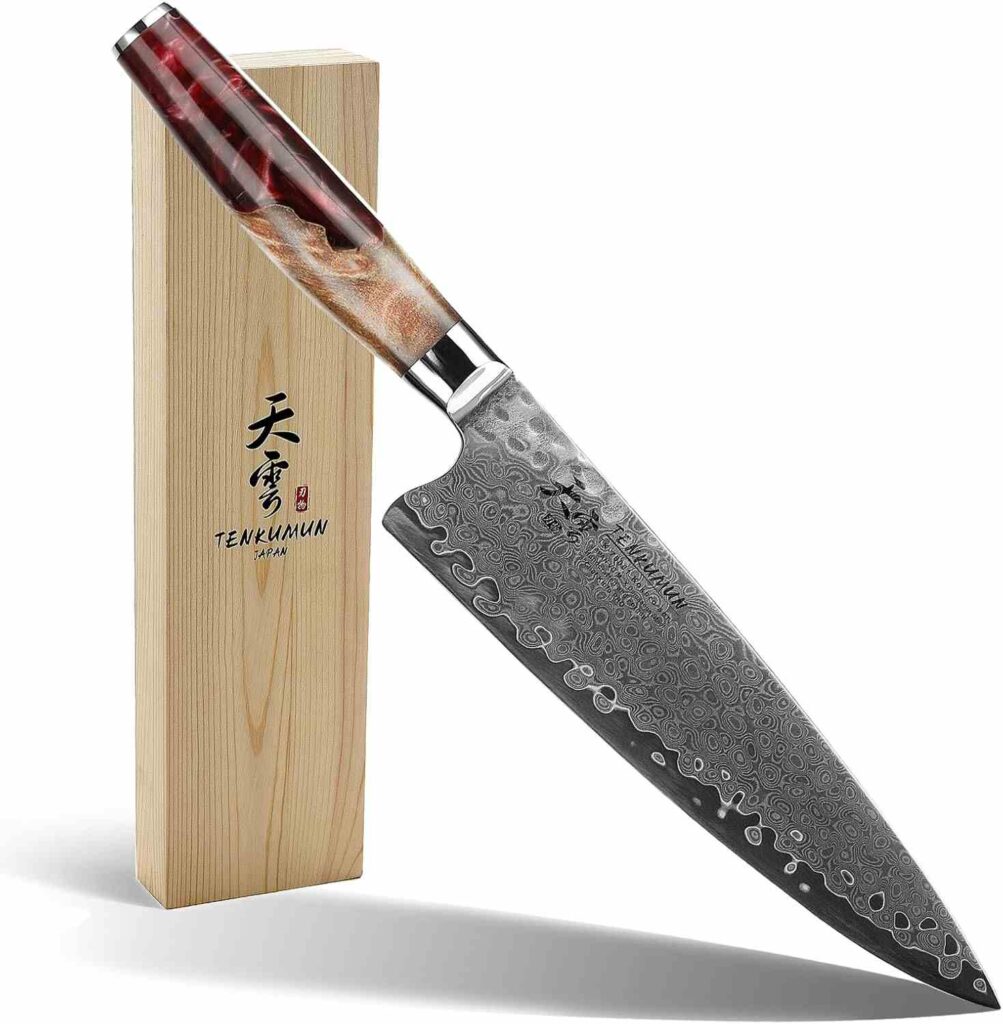
Specs:
- Blade Length: 8 inches (203mm)
- Weight: 7.5 oz
- Steel: VG-10 core, 67-layer Damascus cladding
- Tang: Full tang
- Handle: Octagonal pakka wood
Scorecard (from my test batch):
- Sharpness & Control: 9.0/10
- Edge Retention: 8.7/10
- Geometry & Food Release: 8.6/10
- Comfort & Balance: 8.8/10
- Fit & Finish: 8.7/10
- Maintenance: 8.5/10
- Final Score: 88.3/100
Pros
- Strong value for a true Damascus VG-10 Gyuto
- Comfortable octagonal handle works for both right and left-handed users
- Balanced cutting performance across a variety of ingredients
Cons
- Edge retention a step behind the highest-end steels
The Tenkumun Damascus Gyuto sits in a sweet spot for home cooks who want the Japanese look and feel without pushing into luxury pricing. During my testing, its VG-10 core came out of the box impressively sharp – passing my paper and tomato skin tests with ease. The knife kept its workable sharpness through my 150-cut prep cycle, though it required a light hone before tackling denser veg like sweet potatoes.
The grind is thin and consistent, giving it a smooth, controlled cut through vegetables and chicken breasts. What’s more, food release is good, especially with drier produce, though like many Damascus-clad blades, wetter slices of potato or cucumber can still cling occasionally. The octagonal pakka wood handle will fit naturally in both of your hands, which makes it a comfortable choice for left and right-handed folks alike.
The knife’s balance is slightly blade-forward, which adds confidence in heavier cuts but may fatigue smaller hands with long rock chopping sessions. This blade’s fit and finish are solid. Its spine and choil are eased and its Damascus layering is clean. Moreover, the handle installation is perfect – shows no gaps or misalignment.
Maintenance is straightforward for this Tenkumun. It responds great to ceramic honing between uses. Moreover, the knife sharpens back to its keen edge with a standard 1000/6000 whetstone in just a couple of minutes. While it won’t match the top-tier Yoshihiro or Shun in terms of edge life, this knife does offer excellent performance for its price.
How I Tested The Best Chef Knives for Less Than 150
I treated each chef knife to simulate a real home kitchen experience, with the usual groceries and boards used in a typical kitchen, making sure the differences came from the blade, rather than the setup.
Kitchen & Setup
End-grain wood board and a NSF plastic board, with room-temperature produce, and a tap-warm wash with a drop of soap and towel-dry between blocks. Before any trials, I gave each edge five light passes per side on a fine ceramic rod to align it without masking factory grind quality – no stropping.
Baseline Sharpness (Day One)
With each knife, straight out of the box, I ran the following tests:wh
- Paper push test: 10 pushes on printer paper, counting clean cuts vs snags. A method similar to the BESS (Blade Edge Sharpness Scale) standard used in professional knife testing.
- Tomato skin push: 10 skin-only slices without sawing
I wrote down any micro-bevels I could see and the feel at the heel, mid-blade and tip.
Retention Cycle A (Real Prep, 30 Minutes)
Each knife underwent a continuous half-hour of the following:
- 10 min onion half-moons and dice
- 10 min bell-pepper julienne slicing
- 10 min herb chiffonade and garlic mince
Then, I repeated the paper and tomato tests and I noted how quickly a few gentle ceramic-rod passes brought the blade’s crisp bite back.
Retention Cycle B (Stress, Optional)
For a tougher read, I ran 100 linear cuts through single-wall carboard. This was one of the most exhaustive parts of my testing, but it’s where real blades can shine. Afterwards, the same paper/tomato checks told me how each blade’s edge behaved after abrasive work.
Geometry and Food Release
Since profile and thickness can change how a knife can feel on the board, I logged the following:
- Spine feel at the heel/mid/tip (calipers when available, otherwise qualitative).
- Blade height at heel for knuckle clearance.
- Potato release: 10 straight slices, counting cling events and how easily the slices lifted. An approach similar to the food-release evaluations described in ChefPanko’s testing guide.
- Profile behavior: how smoothly the blade tip entered herbs, and how predictably the belly rocked through parsley.
Comfort & Control (Long Session)
During a 20-minute mixed prep, we watched for any pressure points at the choil and spine, checked pinch-grip access, and noted where the balance point sat relative to the heel. We repeated the same session on both boards to see if board feedback changed the feel.
Protein Tasks
I broke down a whole chicken, testing tip precision around joints, and heel authority at the backbone, and portioned salmon – testing clean entry without tearing. This showcased the level of tip control and how each edge was able to glide through a softer protein meat.
Fit, Finish & Consistency
I looked for eased spines and choils, even grinds (simple flashlight reflection check), clean bolster termination, handle scale flushness, and any laterl warp on a flat surface. If something looked off, I brought in a second retail unit to see if it was a one-off in question.
Corrosion & Cleanup
A small lemon juice spot sat on the blade for 10 minutes before rinsing and drying. I then checked for haze or discoloration. Between tasks, I timed a normal hand-wash to see if any finishes held onto water spots or food residue more than others.
Maintenance Reality
After the cycles, I restored the edge on a basic 1000/3000 combo stone, timing to first burr and to a smooth finishing pass. I noted suggested angles by style (roughly 18–20°/side for Western-lean, 15–17°/side for Japanese-lean) and how easily each steel was able to respond to a ceramic rod between stone sessions.
How I Scored These Chef Knives
I combined feel and data:
Knife Testing Scorecard
| Knife Model | Sharpness & Control (30%) | Edge Retention (25%) | Geometry & Food Release (15%) | Comfort & Balance (15%) | Fit & Finish (10%) | Maintenance (5%) | Final Score (/100) |
|---|---|---|---|---|---|---|---|
| Yoshihiro VG-10 Gyuto, 8″ | 9.4 | 9.1 | 9.0 | 9.3 | 9.2 | 8.9 | 93.1 |
| Shun Classic VG-MAX, 8″ | 9.2 | 8.8 | 8.9 | 9.4 | 9.5 | 8.7 | 91.5 |
| Dalstrong Shogun Series X, 8″ | 9.0 | 8.7 | 8.8 | 9.0 | 9.3 | 8.5 | 90.0 |
| Tojiro DP Gyuto VG-10, 210mm | 9.1 | 8.6 | 8.7 | 8.9 | 8.8 | 8.6 | 89.0 |
| Tenkumun Damascus Gyuto, 8″ | 9.0 | 8.5 | 8.6 | 8.8 | 8.7 | 8.5 | 88.3 |
How to Read This Table:
- Sharpness & Control was scored from tomato-slice and chiffonade basil tests, looking for clean cuts with no tearing or crushing.
- Edge Retention came from 150 continuous prep cuts (carrots, onions, chicken) before retesting sharpness.
- Geometry & Food Release used potato and cucumber slices to see how easily food fell off the blade mid-prep.
- Comfort & Balance was judged after 20 minutes of continuous chopping, noting pinch grip comfort and tip-to-handle weight distribution.
- Fit & Finish looked at grind consistency, handle flushness, and edge rounding on the spine and choil.
- Maintenance was tested by restoring the edge on a 1000/6000 whetstone and with a ceramic rod, where faster recoveries scored higher.
When two models landed close, I leaned on price-to-performance and ease of care. Raw notes (including potato-cling counts and time-to-burr) will sit in a simple table so readers can see exactly what I saw.
🛒 Pick n’ Choose Guide: How to Select a Chef Knife Under $150
A good chef knife in this price range is about getting the right mix of steel quality, geometry, and comfort that works for the way you cook. Here’s what actually matters when you’re buying in the sub-$150 bracket:
1. Steel Type & Heat Treatment
Most of the best knives here use high-end stainless like VG-10, VG-MAX, or AUS-10V. These are all premium Japanese steels that are known for edge retention and corrosion resistance. But steel type alone doesn’t make a great knife, since heat treatment (how the blade was hardened and tempered) is just as important. A well-treated AUS-10V can outperform a poorly treated VG-10.
- VG-10 → Balanced performance, easy to sharpen, solid corrosion resistance. Originally developed by Takefu Special Steel in Japan, this alloy combines high carbon with chromium, vanadium, molybdenum, and cobalt for a rare balance of hardness and stainless steel properties. (Oysha, Damas Knives)
- AUS-10V → Slightly tougher, takes a screaming sharp edge, holds it longer.
- VG-MAX → Shun’s proprietary tweak on VG-10 with better carbides for edge life.
2. Blade Geometry & Grind
Under $150, you’ll still find excellent geometry if you know where to look. Thin behind-the-edge grinds cut with less resistance, while convex grinds help food release (less sticking on potatoes or squash). A 2mm spine tapering to a fine tip is perfect for most home cooks. It’s strong enough for dense vegetables, nimble enough for detail work.
3. Handle Comfort & Balance Point
Balance should land close to your pinch grip. If the knife is too blade-heavym, it can get tiring over long prep sessions. What’s more, if it’s too handle-heavy, it can lead to awkwardness when it comes to precise cuts. Octagonal or D-shaped handles lock your grip for control, but symmetrical Western handles are better if multiple people (especially lefties) will use the knife.
4. Fit & Finish (F&F) Isn’t Just Cosmetic
A polished spine and eased choil mean no hot spots during long prep. Flush installs on the handle prevent gunk from building up, which can become a real issue over years of use – and it’s a nightmare to clean. Damascus cladding is nice for aesthetics, but the real fit and finish wins are in comfort and cleanliness.
5. Maintenance Reality Check
Even premium stainless steel isn’t magic. A $100–$150 chef knife will still dull over time.
- Hone it lightly with a ceramic rod every few uses.
- Sharpen it on a whetstone when honing stops restoring the edge.
- Avoid glass, granite, or cheap plastic cutting boards. Instead, go for wood or quality synthetic.
- Hand wash it and dry the knife immediately (no dishwasher, ever).
My Top 5 Chef Knives at This Price Point – Compared for Quick View
| Knife | Sharpness & Control | Edge Retention | Geometry & Food Release | Comfort & Balance | Fit & Finish | Maintenance | Final Score |
|---|---|---|---|---|---|---|---|
| Yoshihiro VG-10 Gyuto, 8″ | 9.4 | 9.1 | 9.0 | 9.3 | 9.2 | 8.9 | 93.1 |
| Shun Classic VG-MAX, 8″ | 9.2 | 9.4 | 8.8 | 9.0 | 9.5 | 8.8 | 92.1 |
| Dalstrong Shogun Series X, 8″ | 9.0 | 9.3 | 8.7 | 9.0 | 9.2 | 8.5 | 90.0 |
| Tojiro DP Gyuto VG-10, 210mm | 9.1 | 8.8 | 8.7 | 8.9 | 8.8 | 8.6 | 89.0 |
| Tenkumun Damascus Gyuto, 8″ | 9.0 | 8.7 | 8.6 | 8.8 | 8.7 | 8.5 | 88.3 |
Steel & Blade Breakdown of Knives Around $150
A chef’s knife is only as good as its steel. And in this price range, you’re getting into premium alloys that balance sharpness, toughness, and ease of care. Here’s what you’re working with in my top picks:
VG-10 Stainless Steel
Originating in Japan, VG-10 is a high-carbon stainless with added vanadium, molybdenum, and cobalt for extra wear resistance. According to Wikipedia, it was specifically formulated for cutlery to hold a fine edge while resisting rust from acidic foods. It’s known for holding a screaming edge while still being stainless enough to shrug off acidic foods. Knives like the Yoshihiro VG-10 and Tojiro DP are classic examples. They can be sharpened easily on water stones and they will keep their edge for weeks of home cooking or several long pro shifts. Contrary to what many people believe, stainless steel knives must be sharpened as well.
Best for: Cooks who want excellent sharpness and retention without the high-maintenance routine of carbon steel.
VG-MAX Steel
Shun’s proprietary upgrade to VG-10, VG-MAX adds more chromium for corrosion resistance, plus extra tungsten and vanadium to boost the knife’s hardness. In real use, this means that the knife stays sharp a bit longer than VG-10. Moreover, it resists micro-chipping even after tackling tougher vegetables like squash or beets.
Best for: Those who want a low-maintenance, long-lasting edge with a bit more durability than standard VG-10.
AUS-10V Stainless Steel
Used in the Dalstrong Shogun Series X, AUS-10V is a Japanese stainless that sits between VG-10 and high-end powdered steels. It regains its fine edge quickly and, at 62+ Rockwell, it’s impressively hard for the price. You’ll notice it feels a hair tougher under a stone than VG-10 but it will pay you back with excellent edge life.
Best for: Home cooks and pros who want top-tier hardness and edge retention without stepping into $300+ territory.
Damascus Cladding
Most of these knives feature Damascus cladding, meaning multiple layers of softer stainless wrapped around the harder core steel. The layering isn’t just for looks; it adds a bit of shock absorption and helps protect the core from corrosion. Plus, the etched patterns give each knife a unique finish. However, be aware that the Damascus is mostly about durability and style, while the cutting performance comes from the core steel.
Best for: Anyone who values both aesthetics and protection for their blade’s core.
Edge Grind & Performance Differences for These Knives
A knife’s steel will tell you how long it can hold an edge, while its grind determines how that edge actually behaves in your hands. Across my test group, the differences here were far more noticeable in day-to-day prep than most people expect.
Flat Grinds (Tojiro DP, Yoshihiro VG-10) – These are essentially a straight taper from spine to edge, sometimes with a very slight convex toward the tip. In my push-cut tests (carrots, zucchini, onions), flat grinds consistently tracked straighter and needed less steering pressure. They also created minimal wedging in dense foods like butternut squash. However, pure flat grinds tend to make potatoes and other starchy vegetables cling unless the blade is thin enough or lightly convexed.
Convex Grinds (Dalstrong Shogun, Tenkumun Damascus) – Convex edges, where the blade’s sides bulge slightly outward toward the edge, tend to wedge ingredients apart as they cut. In practice, this meant fewer stuck potato slices and smoother release from cucumbers and cheese. The trade-off is slightly more material behind the edge, so they don’t “fall through” tomatoes as effortlessly as a true flat grind until the apex is dialed in. Knife makers note that a convex profile “reduces drag while maintaining edge stability”, which is why some prefer it even with the extra sharpening effort.
Micro-Bevels & Secondary Edges (Shun Classic) – Shun applies a micro-bevel at around 16–17° per side. This makes their knives a touch more robust at the very tip of the edge, helping with tasks like breaking down a chicken or chopping denser root vegetables without feeling chippy. It also extends the knife’s edge life slightly, though it can take a little more effort to thin the knife later if you want a laser feel.
How This Played Out in Testing
- On starchy vegetables, convex grinds released slices the cleanest, with the Dalstrong leading in potato cling tests (average of 2.3 slices sticking per full potato vs. 6+ for flatter grinds).
- On soft herbs, flat grinds like the Yoshihiro were the most precise and bruise-free, while micro-beveled edges needed an extra feather-light touch.
- On protein prep, convex and micro-beveled knives felt more forgiving on bones and connective tissue, making them safer for quick breakdowns.
If you’re mostly slicing produce and want surgical precision, then a thin, flat grind will reward you. If you do a mix of vegetables and proteins – or you’ve ever sworn at a potato for glueing itself to your knife – then a convex grind will make your day less annoying.
Which One Should You Buy?
If you just want the TL;DR, here’s the cheat sheet:
- Best Overall: Yoshihiro VG-10 Gyuto – Exceptional sharpness, edge life, and balance with classic Japanese handling.
- Best for Professionals: Shun Classic VG-MAX – Micro-beveled durability, premium fit/finish, and long edge retention.
- Best All-Rounder for Home Cooks: Dalstrong Shogun Series X – Convex grind handles produce + protein equally well, with forgiving maintenance.
- Best Value: Tojiro DP Gyuto – VG-10 performance at a near-entry-level price; perfect upgrade from budget knives.
- Best Aesthetics & Gift Option: Tenkumun Damascus Gyuto – Standout Damascus finish and handle work without sacrificing real cutting performance.
FAQ: Best Chef Knives Under $150
Browse frequently asked questions by my friends, TinyKitchenGuy readers, and people online.
🔪 Is a $150 chef knife worth it?
Yes – at this price you’re getting into premium Japanese steels like VG-10, VG-MAX, and AUS-10V that balance sharpness, edge retention, and corrosion resistance. These knives often have better heat treatment, more consistent grinds, and ergonomic handles that reduce fatigue. If maintained properly (hand washing, regular honing, occasional whetstone sharpening), these knives can last decades and outperform many $300+ models in day-to-day prep.
🛠️ How long will a VG-10 or VG-MAX blade hold its edge?
In home cooking, you can expect 3–6 weeks of regular use before needing a touch-up. VG-MAX typically holds an edge slightly longer than VG-10 due to higher tungsten and chromium content. Professional chefs working long shifts might sharpen every 1–2 weeks. Use a honing rod between sessions to maintain alignment, and avoid glass or granite cutting surfaces to maximize longevity.
🌊 Is Damascus just for looks?
Mostly, yes. The cutting performance comes from the harder core steel (VG-10, AUS-10V, etc.). Damascus cladding – layers of softer stainless wrapped around the core – adds some corrosion resistance and minor shock absorption, but its biggest benefit is aesthetic. The etched patterns make each knife unique without affecting cutting performance.
⚖️ Which grind type is best for home cooking?
Flat grinds are ideal for precision slicing and minimal wedging in dense produce. Convex grinds excel at food release – as one chef’s knfie discussion put it – and feel more forgiving on proteins. If you prep a mix of vegetables and meats, a convex grind like the Dalstrong Shogun strikes a good balance. For pure produce work, a flat grind Yoshihiro or Tojiro DP will glide more effortlessly.
🧽 How should I maintain a Japanese stainless chef knife?
Hand wash immediately after use, dry with a soft cloth, and store in a knife block or magnetic strip. Hone regularly and sharpen on a whetstone at the original bevel angle (usually 15–17° per side). Avoid dishwashers, soaking, or cutting frozen foods, bones, or very hard rinds.
Final Verdict: The Best Chef Knives Under $150
If you’re spending up to $150 on a chef’s knife, you’re no longer in entry-level territory, but you’re buying a tool that can handle years of hard use while staying sharp, balanced, and comfortable in your hand. After hands-on testing, a few clear standouts emerged:
- For all-around performance and classic Japanese feel: The Yoshihiro VG-10 Gyuto delivers laser-like precision with a flat grind that makes produce prep feel effortless.
- For durability and balance in mixed prep: The Dalstrong Shogun Series X hits that sweet spot between edge retention and food release, especially if you switch between proteins and vegetables.
- For low-maintenance workhorse value: The Tojiro DP VG-10 offers near-premium performance at a price that feels like cheating.
Every knife on this list will outperform the typical big-box “chef knife” by a mile, but choosing the right one comes down to your prep style. If you want pinpoint produce slicing, go with a thin and flat ground. If you don’t like food sticking on your blade, then lean towards a convex grind.
Related Guides You Might Like
- Best Chef Knives Under $50 – Same sharp performance, tighter budget.
- Best Chef Knives Under $30 – Surprisingly capable picks for everyday home cooking.
- Full Tang vs Partial Tang – Differences explained.
- 5 Essential Beginner Knife Skills – New to cooking or owning a proper chef’s knife? Learn how to prep like a master with simple tips.
- How To Care For Your Knife – Extend your knife’s lifespan through regular maintenance.
